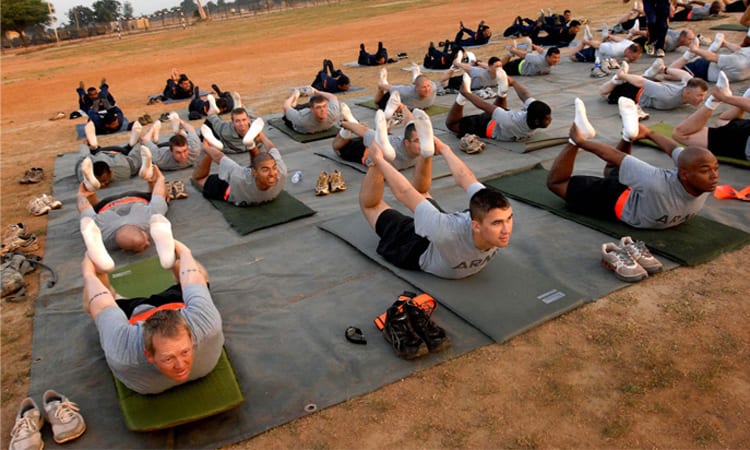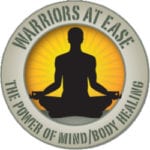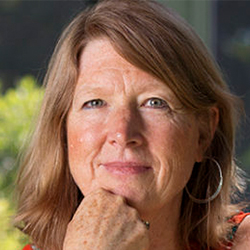 Much of Robin Carnes’s work has been dedicated to the service and support of soldiers and their families. In 2013, The Smithsonian Institute recognized Robin for bringing Yoga and meditation to military communities. She co-founded Warriors at Ease (WAE), an organization that trains and deploys Yoga and meditation teachers to work with military communities, and she served as lead instructor of the first Defense Department-funded feasibility study of Yoga Nidra meditation for PTSD symptoms. Following the study, she was part of a special program at Walter Reed Military Medical Center treating patients with acute PTSD and traumatic brain injury (TBI) for six years. In the following interview, Robin discusses the approach of WAE, describes benefits of iRest Yoga Nidra, and shares her experience working with military communities.
Much of Robin Carnes’s work has been dedicated to the service and support of soldiers and their families. In 2013, The Smithsonian Institute recognized Robin for bringing Yoga and meditation to military communities. She co-founded Warriors at Ease (WAE), an organization that trains and deploys Yoga and meditation teachers to work with military communities, and she served as lead instructor of the first Defense Department-funded feasibility study of Yoga Nidra meditation for PTSD symptoms. Following the study, she was part of a special program at Walter Reed Military Medical Center treating patients with acute PTSD and traumatic brain injury (TBI) for six years. In the following interview, Robin discusses the approach of WAE, describes benefits of iRest Yoga Nidra, and shares her experience working with military communities.
You have worked extensively with military communities. What drew you to working with these communities and to found WAE?
At the time, it felt like happenstance. I lived within two miles of Walter Reed Medical Center for many years. I had never been inside the hospital or worked with military communities before. I got called in to do this study—the first ever study with Yoga and meditation—regarding the feasibility of iRest Yoga Nidra. I was very interested in that and how it could be helpful to someone who had traumatic experiences. I had personal experience with trauma, but, at the time, I didn’t know to call it that. I got to start working with people who had trauma experiences that were very different from those that I had experienced. These patients were experiencing a battle, like there was a war going on in mind and body. In many ways, the folks I worked with were so different from me—men, people of color, people of various different socioeconomic backgrounds—and military culture itself was very different. It was so different, and yet it was perfect for me. I felt like everything that I had ever done had brought me to that place. I had done most of the training for social work and I had gone to inity school. All my personal experience enabled me to relate to the service members and to understand the culture enough to translate the practices into language that they could tolerate and experience. Once they tried the Yoga Nidra meditation, the response they had was so profound that I was riveted by it. I thought, it’s just not right that it’s only available in small pockets when all these people are suffering; we have to get this out to all veterans and active duty personnel, and their families. My personal experience with trauma gave me an ability to do the work. I was able to establish kinship with the people and have spiritual experiences with them. We had incredible experiences together. I knew all along that the work was teaching me Yoga in ways that I couldn’t image. All my ideas, judgments, and delusions were being stripped away. It was amazing to be a witness to the courage expressed by the people who participated in the study, the courage to try something that seemed ridiculous, as well as to be a witness to their vulnerability, strength, loyalty, and duty. I have tremendous respect for them. Warriors at Ease was an idea that was born out of these experiences. I was sitting in a ten-day meditation retreat when I received a transmission: you’re going to start an organization to share the healing practices of Yoga with the military. I foresaw it being standardized in VA and all DOD settings. Little did I know what a big thing this was that came to me. Then I collaborated with three other women so that we could train many more to do this work.
 How are the approaches used in Warriors At Ease uniquely tailored to military communities? How are the teachings different from those of typical Yoga trainings, for example?
How are the approaches used in Warriors At Ease uniquely tailored to military communities? How are the teachings different from those of typical Yoga trainings, for example?
There are three primary distinctions about the approach that WAE takes. One is that our teachers are trained to be culturally informed in order to work with military communities. You get the most traction in whatever you have to offer if you can meet people where they are and speak a language with which they can make a connection. It’s a cultural sensitivity thing. If we started speaking in Sanskrit about Shiva and Shakti, nobody would be interested. This has its place in Yoga teachings and practices, but it’s probably not effective for military communities; in fact, it’s very likely ineffective. There are some iniduals who would be very receptive to that, but, overall, it’s super important that teachers understand military values, norms, and structure so that they can talk to service members and veterans in a way that won’t create barriers or reinforce existing stereotypes. If you put yourself in the shoes of those in the military community, you would see that Yoga doesn’t look like it’s for them. Seeing a cover of a Yoga magazine, they might think, “Yoga looks like it’s for rich white women,” “That might hurt me,” or, “If everything hurts, why would I want to do that to my body?” They aren’t interested in that. They are really interested in sleeping better, experiencing less pain, mood management, and relieving anxiety and depression. Yoga can address and deliver on all those things. That’s the way you present Yoga, rather than describing it as a spiritual pursuit. It doesn’t mean Yoga’s not that; it’s just not what you focus on when you introduce it to them. The second distinction of the WAE approach is that it is evidence based. The practices are based on scientific studies that have shown that Yoga practices have a positive impact on stress-related conditions by activating the parasympathetic nervous system. For example, we know that a certain breath technique and a certain asana practice will produce this effect. We rest our techniques on evidence. Lastly, the approach of WAE is to teach in a trauma-sensitive way. Not everyone has trauma, but in many cases, the teacher doesn’t know which students have. You have to treat every situation like it is trauma-sensitive, because you don’t want to inadvertently trigger someone. And that’s why we train our teachers extensively regarding trauma.
You’re an instructor of iRest Yoga Nidra,a research-based transformative practice of deep relaxation and meditative inquiry, which is currently being utilized in VA hospitals, military bases, hospitals and clinics, hospice, homeless shelters, community programs, and schools. What’s the relationship between Warriors at Ease (WAE) and iRest? Do all WAE teachers use iRest?
Not all WAE teachers use iRest, but we encourage it. We train Yoga teachers of all lineages. We teach them what makes something trauma-sensitive or not, what’s effective for stress, what makes something contraindicated, and how to teach what you love to teach in a way that is trauma and culturally informed. iRest Yoga Nidra was my primary modality at Walter Reed. I called Richard Miller, told him what I was involved in, and asked if he could help. He said yes, and he was my mentor for many years. Essentially, the practice is an adaptation of ancient Yoga Nidra; it’s trauma-sensitive, culturally-sensitive, and evidence-based. It is absolutely and fantastically received because barriers of language have been removed. It’s good for everybody, but it’s especially great because people who have trauma are not triggered by it. I taught for six years at Walter Reed, and iRest is still being taught there in many departments. Service members and veterans really love it. You can give them a recording, and they can take it with them. So iRest Institute and WAE have no formal ties, but most of the top WAE teachers are also iRest teachers. We think it’s an amazing tool.
You mentioned that service members and veterans are very interested in getting a good night’s sleep and reducing pain. Is iRest helpful for that?
Yes, iRest is really great for alleviating PTSD symptoms, improving sleep, and reducing chronic pain. Some studies have been conducted to investigate the ability of iRest to support military couples when they practice together. The studies are taking into consideration many angles like PTSD symptoms, insomnia, chronic pain. Since Yoga tends to be outside of their experience, it’s helpful in meeting with new veterans when you can say, “This practice was developed for war-fighters at Walter Reed.” This approach helps to get them to try it. In general, military folks don’t typically think of themselves as yogis or meditators. They consider meditating to be sitting in Lotus pose with spine erect, and to some that looks so uncomfortable, or like a mystical thing that would conflict with their religious beliefs. But it’s much more approachable when you realize you can lie down, and if you fall asleep, no one’s going to wake you up.
What Yoga practice(s) would you recommend to readers?
For a practice, I would recommend iRest Yoga Nidra. It brings about parasympathetic activation that counters the fight-or-flight response, allows for a practitioner to meet and welcome any sensation, emotion, or thought, and to experience the part of themselves that is pure awareness. This all can happen without talking about koshas, chakras or Samadhi (even though all those things are true too). iRest helps us experience our innate wholeness. That’s ultimately what we all want.

